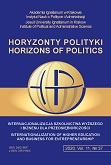Zjawisko zahibernowanej propagandy politycznej w nowych mediach
Hibernated Propaganda in the New Media
Author(s): Mirosław Lakomy, Konrad OswiecimskiSubject(s): Media studies, Political history, WW II and following years (1940 - 1949), Present Times (2010 - today), Fascism, Nazism and WW II
Published by: Uniwersytet Ignatianum w Krakowie
Keywords: Goebbels propaganda; Leni Rieffenstahl; propaganda hibernation; YouTube; neo‑Nazism;
Summary/Abstract: RESEARCH OBJECTIVE: The article aims to draw attention to the problem of the implicit consent to Göebbels propaganda and the acceptance of the idea of Nazism which takes place away from the mainstream public discourse but reaches pretty high levels. This problem is particularly visible in the new media and can be observed particularly clearly on the YouTube platform, which has become, for neo Nazi circles, a place of political agitation. THE RESEARCH PROBLEM AND METHODS: The basic research method for the article is the analysis and interpretation of source materials found on YouTube. These include propaganda materials “produced” under the direction of Joseph Goebbels and “hibernated” in this repository, as well as comments and secondary “productions” of supporters of this ideology. The work also includes an analysis of the process of amplifying propaganda in social media in order to show the strength of its impact on generations Y and Z. THE PROCESS OF ARGUMENTATION: The article consists of two essential parts. The fir st presents historical issues related to Joseph Goebbels’ propaganda and a whole series of media productions for the mental subordination of German society. The second shows the impact of these productions, hibernated in social media and especially YouTube, on generation Y and Z, which grew up in a post war democracy. RESEARCH RESULTS: The main conclusion of the analysis is the thesis about the strong influence of Goebbels propaganda, hibernated in social media, and its destructive impact on generations of young people in Europe. This is the first text to draw attention to this very dangerous process. The analysis shows that beyond the main current of public discourse, there is a gradual rematch of the revanchist and neo Nazi movements, which poses a threat to the political order of contemporary Europe. CONCLUSIONS, INNOVATIONS AND RECOMMENDATIONS: Because of the historical references to the 1930s and 1940s, the article may serve as a basis for reflection on contemporary crises and threats to democratic systems, providing some warning against a return to a justly bygone era of totalitarianism.
Journal: Horyzonty Polityki
- Issue Year: 11/2020
- Issue No: 35
- Page Range: 105-123
- Page Count: 19
- Language: Polish

